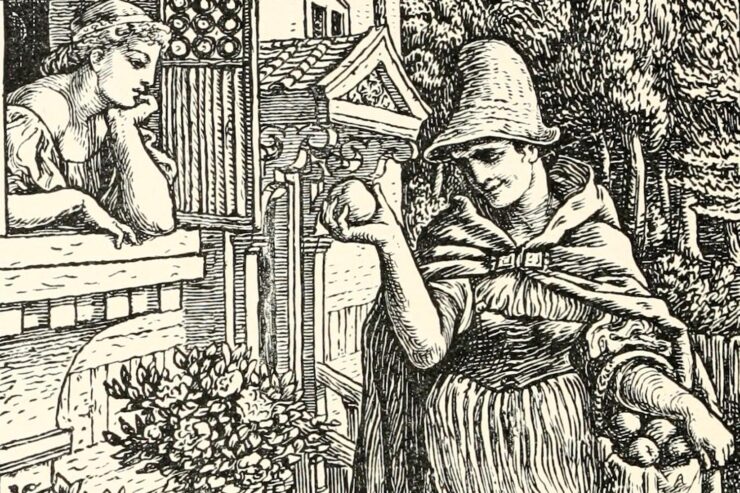This maiden sleeps, not in a tower covered with thorny roses, but in a coffin made of jewels and glass. Snow White, with her red lips, black hair, and white skin, has captivated our cultural imagination for centuries (though her cursed sleep didn’t last nearly as long as that other gal’s). Equally memorable is the evil queen’s mirror, which has enchanted writers into countless reinterpretations: imagine a mirror that can answer all of your questions (bonus points if you can put them in the form of a rhyme!). The relationship between these two women is, I think, the most interesting part of this tale. The father fades into the background, the prince is little more than a footnote. There are too many dwarves for us to get to know them all well. But the two women at the heart of “Snow White” reveal much about our cultural obsession with youth and beauty and the constricting and stereotyped gender roles forced upon women through history, right up into the present day.
Just in case you need a refresher, here’s a handy recap of “Snow White” (of course, there are many versions of the tale—even the Brothers Grimm revised their take on Schneewittchen once or twice—but the summary below touches on most of the common elements)…
A young queen prepares to give birth to her first child, and as she sits at her window on a snowy day, pricks her finger on her embroidery needle. Her blood lands on the snow against the dark stone of the window sill, and she wishes for a daughter with skin as white as snow, hair as black as ebony, and lips as red as blood. Perhaps it would have been better to wish for a birth that left both mother and child healthy, because the queen’s wish does come true, but soon after the birth she dies, leaving her young daughter motherless, to be looked after by the caring but busy father/king.
Buy the Book
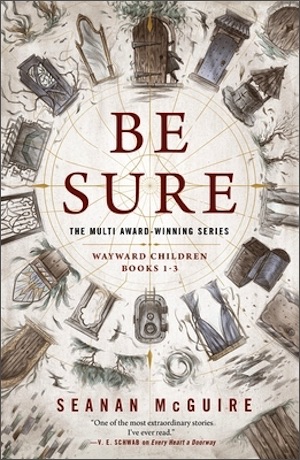

Be Sure
The king remarries, and Snow White’s beautiful stepmother becomes the new queen. Vain and spiteful, the queen watches the princess grow into a beauty herself, daily asking her mirror to confirm that she, the queen, is the most beautiful in the land. On the day the mirror replies in the negative, pointing out that Snow White has exceeded the queen’s beauty, the queen decides that the only possible solution to this problem is murder. She sends her trusted huntsman to kill Snow White and bring back the girl’s heart.
The huntsman sets off on his task, seemingly willing enough, but when it comes time to make the kill, he has mercy on Snow and sends her into the forest, never to return. He kills a deer and takes its heart back to the queen instead, who promptly consumes it, relishing in her victory.
Snow White, meanwhile, stumbles upon a little cottage deep in the forest. She helps herself to some food and then falls asleep, and the owners of the house, seven dwarves, find her sleeping. After some argument, they come to a mutually beneficial arrangement, exchanging housekeeping and cooking services for room and board. This makes everyone happy except for the queen, who finds out the truth when she asks her mirror to confirm that she’s retaken first place in the magical beauty contest, and the mirror points out that Snow is still looking pretty good for a girl who’s supposed to be dead.
No more delegating—the queen plots to take Snow White out with her own two hands, disguising herself as an aged crone and first using the laces of a bodice to stop Snow from breathing, then employing a poisoned comb—and isn’t it interesting that she chooses items used for the maintenance of feminine beauty standards!? The dwarves manage to save Snow from both of these ploys, but when the queen returns for a third attempt—offering the princess a poisoned apple—they are too late. Although Snow seems to be dead, she is also frozen in her youthful beauty, and the dwarves figure that it would be a waste to bury her, so they build a glass coffin and put her on display.
Luckily, a handsome prince happens by, and is awed when he glimpses the sleeping Snow White. He either kisses her awake, or asks the dwarves if he can take her and put her on display somewhere that more people can see her, and the jostling of the coffin dislodges the apple and wakes her, depending on who you ask (I’m not sure either is necessarily better). The prince declares his love for this beautiful stranger who just woke up, and Snow White doesn’t want to go home so she agrees to marry him. They summon her stepmother to the wedding, and when the queen shows up, the prince commands that red-hot iron shoes be placed upon her feet, and she is made to dance until she dies. How much dancing she actually does is left open to interpretation.
And Snow White lives happily ever after….
In “Snow White,” the push and pull between youth and age seems as stark as ebony black hair against palest white skin, and many versions of this story highlight the difficulty of being a woman whose entire value and relevance is tied to her looks and her ability to appear attractive. Closer examinations break these conventions apart like cracks in a looking glass, and there’s a lot of narrative potential to be mined from questioning the assumptions and stereotypes that underlie the original tale. Here are seven tales that shatter and remake the story, change the relationship between step-mother and step-daughter, and reflect the aspects of the story that speak to us today.
A Mirror Mended by Alix E. Harrow
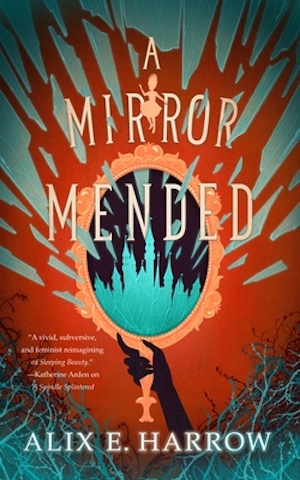
Following Zinnia Gray’s adventures in A Spindle Splintered, this delightful continuation tackles the other major sleeping princess story as Zinnia finds herself yanked out of the part of the multiverse filled with infinite versions of “Sleeping Beauty” and pulled instead into the story of Snow White and her wicked Stepmother. Only, she wasn’t drawn there by the endangered princess, but rather by the queen; in a moment of desperation-fueled magic, the evil queen reaches out to Zinnia through her mirror and drags her into another paradigm altogether. Zinnia has to learn to navigate the new rules of this story-world while temporarily allying with a queen she initially sees as the antagonist…until she realizes that the queen was a young princess, once, too, and is perhaps as much a victim of circumstance as Snow White ever was. Another love letter to fairy tale enthusiasts, Harrow’s clever update has a happy ending (although the “ever after” part remains to be seen).
“Snow, Glass, Apples” by Neil Gaiman
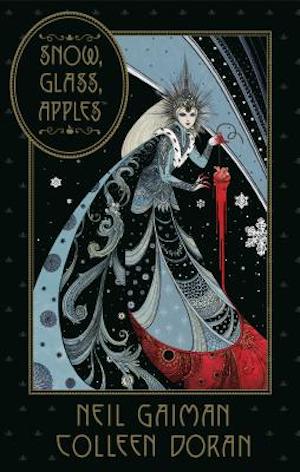
Gaiman fans will already be familiar with this dark gem of a story, but if you HAVEN’T read this version: brace yourself. In one of the most chilling retellings I’ve found, Gaiman asks what kind of creature is pale as snow, has lips red as blood, and has to have its heart destroyed in order to defeat it? The elements are all inverted here (stepmother, magic mirror, handsome prince), reminding us that history is written by the winners. Told in delicious prose, this one will make you shiver.
“Snow in Dirt” by Michael Blumlein (from Black Swan, White Raven, edited by Ellen Datlow and Terri Windling)
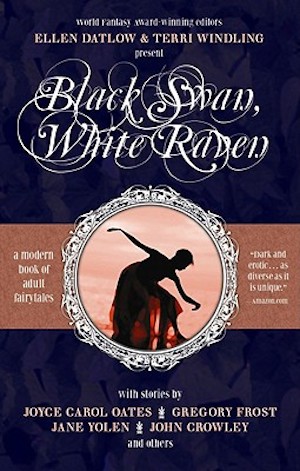
When Frank digs the girl of his dreams out of some property he’s trying to restore in this seemingly futuristic retelling, he’s not quite sure what to do about it, but seeks advice from his brother, his sister, and his ailing mother. It takes the newly unearthed woman long enough to wake that he calls her Vexing, and when she does at last wake she doesn’t contradict the name. Her transformation from fairy tale princess to fairy tale queen is both more subtle and more sympathetic than we find in many renderings, and gives the reader space to ponder what the relentless need to be considered beautiful can do to a woman’s heart. The ending is melancholy, but perhaps leaves room to hope that society can change as much as any individual.
“Snow in Summer” by Jane Yolen (from Black Heart, Ivory Bones edited by Ellen Datlow and Terri Windling)
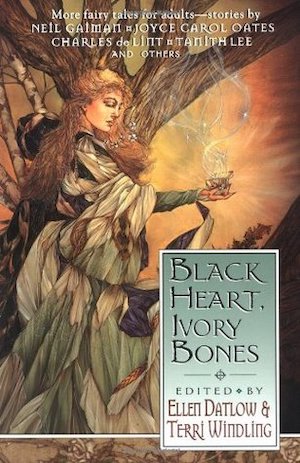
Imbued with Appalachian charm, Yolen’s retelling centers on a girl whose mother names her after a flower, Snow in Summer. It follows a straightforward path through the traditional tale until stepmama comes calling after Summer has been hiding in the woods for seven years and has made a sweet home for herself. Summer cooks and keeps a garden, cleans, and tells stories to her new companions, miners from the local mountains. The story takes an abrupt turn as Yolen reminds us that it’s not the stories that we know, but the choices we make, that enable us to create our own endings.
“Snow’s Kingdom” by Rachel Ayers (from Lady Churchill’s Rosebud Wristlet #46)
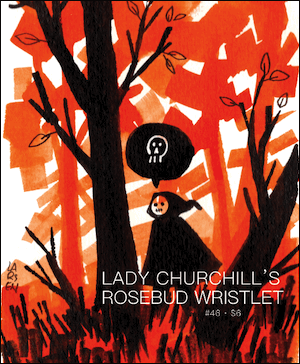
If I may be so bold as to offer my own interpretation of the tale: this retelling is about a young prince whose mother encourages him to follow his heart. His father, the king, is not so understanding, and when the queen dies and the king remarries, the prince finds his home unbearable. Young Snow begins slipping away to visit a nearby brothel, where he makes friends who help him discover what it means to be true to oneself, regardless of what anyone else thinks. When the king seeks out his son, he finds a lovely young maiden with his son’s bright eyes. He’s outraged, but Snow is determined to stand by her new friends and her own heart’s longing.
Snow White: A Tale of Terror (1997)
This horror-fueled retelling draws on the almighty talent of Sigourney Weaver in the role of the stepmother, imbuing her with understanding and nuance. Although it’s a fairly straightforward retelling, it’s worth watching for Weaver’s sympathetic transformation from a stepmother who’s trying desperately to get along with her new family to a distraught mother who loses herself in darkness. The rather bland Lilianna (the movie’s version of Snow White) and Weaver’s Lady Claudia almost never manage to get along, but there are moments when they nearly connect, and it’s clear that the story could have gone another way. Weaver gives the audience as sense of the cultural pressures that weigh on a woman as she ages, playing a woman longer in the first flush of youth who still wants a baby of her own, rather than anything so simple as a vain and jealous villain.
“The True Story” by Pat Murphy (from Black Swan, White Raven, edited by Ellen Datlow and Terri Windling)

I almost hesitate to include this one on this list, because part of the pleasure of reading this story is the dawning recognition of coming at something familiar from an unlikely angle. The queen narrates the story herself, but her fierce affection for the previous queen’s daughter completely changes the tone in this short, masterful retelling. Murphy interrogates the tendency to oversimplify women’s relationships with each other that we see in so many tales, as well as the casual way storytellers often dismiss far more likely sources of danger in a young girl’s household in their rush to lay the blame. Although this story isn’t graphic, it is uniquely visceral, beautiful, and searing.
***
There are hundreds of reimaginings of Snow White that interrogate the lines between beauty and wisdom, between mother and daughter, between the world and its expectations of women. Which are your favorites? Share in the comments!
Rachel Ayers lives in Alaska, where she writes cabaret shows, daydreams, and looks at mountains a lot. She has a degree in Library and Information Science which comes in handy at odd hours, and she shares speculative poetry and flash fiction (and cat pictures) at patreon.com/richlayers.










